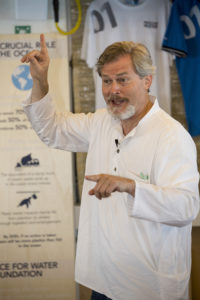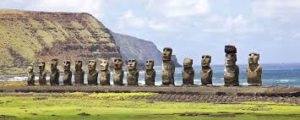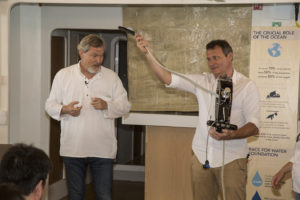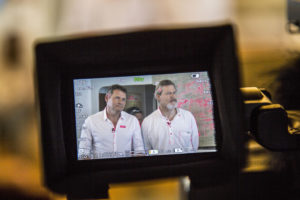In early 2018, the Race for Water Foundation began a collaboration on an international scale with the ZERI Foundation (Research and Initiatives for Zero Pollution) and its founder Professor Gunter Pauli, father of The Blue Economy.
Marco Simeoni: “Through his Foundation, Gunter Pauli is keen to make the iconic Easter Island self-sufficient in energy. The Race for Water Foundation is joining this project with a view to contributing to the waste recovery aspect. We’re absolutely delighted with this collaboration, which we hope will inspire other similar projects to be created on remote islands.”

Interview with Mr Gunter PAULI:
You’re a trained economist; how did you become interested in ecology?
I was the owner of a factory manufacturing detergents. I noticed that what formed the basis of my company was the use of palm oil, which was destroying forests as well as the habitat of orang-utans. I wondered how I could be a green entrepreneur whilst destroying the ecosystem in the tropical rainforest. That’s really what turned things around for me. I sold my company and created the ZERI Foundation (Research and Initiatives for Zero Pollution).
Could you explain to us what The Blue Economy is exactly?
The Blue Economy is fairly elementary. We use what is available locally with the aim of creating profit. Above all, we’re keen to satisfy the needs of the local population. We’re not about focusing on cheaper production to conquer the global market. We simply want to create an increase in a thing’s value. Once we’re into this set-up, we’re more competitive and we generate more assets for local consumers and clients.
To my mind, nature teaches us that we need to look for solutions where the latter has been proving that it works for millions and millions of years.
The only Being on earth capable of producing waste is Man. The idea is that other human beings never produce waste because everything that is produced is always transformed into an energy, a nutrient or a material for someone else.
You simply have to adhere by the wisdom of the ecosystems, which supply energy and food, recycle waste, satisfy the needs of everyone and are constantly regenerating. You have to implement new intelligent solutions, adapted to each local situation by designing production cycles inspired by how nature works, where there is never any waste and where everything is recycled in a harmonious process.
You’ve set up an experiment on the island of EL HIERRO in the Canaries; can you tell us about it?
The population of this island believed that within the next 20 to 30 years, no one would live there any more, that the entire population would leave for Barcelona, Valencia or Madrid. At that point, the bulk of the inhabitants rallied together to take up the challenge of remaining on site, even to the extent of getting their children to come back.
From then on, everything was devised to set up different activities like fishing, goat breeding, agriculture, vineyards, abattoirs, energy, water and waste treatment and so on.
Today, EL HIERRO has become a reference island in Spain. There is a higher density of fish than elsewhere in Spain; the price per litre of goat’s milk is 2.65 euros; the wine production amounts to 180,000 litres, which isn’t massive, but it’s produced locally. We’ve managed to generate profit and maintain cash flow that continues to circulate locally, which is very important economically as this has a multiplier effect.
You plan to adopt a similar approach in making Easter Island self-sufficient in energy?

Indeed I do. When you manage to turn an island around that had no future, it gets you thinking about how other islands could follow this example.
At the time of the El HIERRO project, we knew nothing about hydrogen and had no idea about the integration of an energy produced from transforming plastic, so now seems to us to be the right time to change the Easter Island model.
In South America, everyone knows that the Rapa Nui are experiencing a genuine ecological disaster.
We’re joining forces with Race for Water because with our respective experiences, we’re going to be able to focus on solutions and finding a portfolio of opportunity!
What do the Oceans represent for you?
Human Beings believed that the solution lay in the food, energy and water that could be found on land. However, the earth represents 30% of the planet and the oceans 70%! Why limit ourselves to a layer of earth measuring a matter of centimetres for our production? There is a way to make more use of the oceans to meet our future food and energy needs. In the oceans, you have three-dimensional production, which enables otherwise unachievable levels of productivity. Water has a density that is greater than that of air; the nutrients you can distribute are more effective than those distributed via the land.
Look at seaweed for example. It can protect the marine fauna, play a part in the biodiversity of the oceans and also enable large quantities of biogas to be produced to assist with energy production.


Was it an obvious move for the Race for Water and ZERI Foundations to come together on the Easter Island project?
Race for Water owns a boat, which is a miniaturisation of a portfolio of technologies, which only works with what is available locally (wind, sunshine, seawater), to draw out the benefits such as propulsion, drinking water, etc. To my mind, it’s the same way of thinking and I’d like to prove that you can transform a reality with what we have within arms’ reach.
We have similar cultural approaches: we take action, we prove that it works and, through that, we have the opportunity to inspire people to take up the baton.
Our two Foundations cannot revolutionise the world on their own. We need to inspire people in practical terms, so that everyone takes action to change the world.